Table of contents
- Sprint duel Yamaha Vmax versus VW Beetle
- 200 horses against 1 beetle
- And who is ahead of the game??
- Who is faster?
- What’s really up?
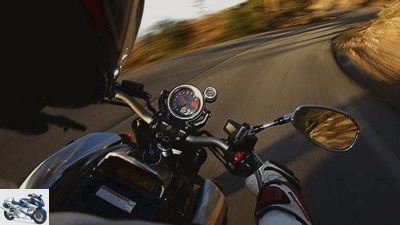
Artist
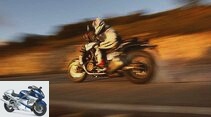
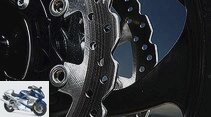
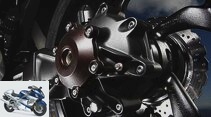
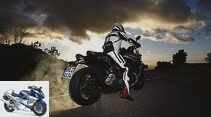
38 pictures
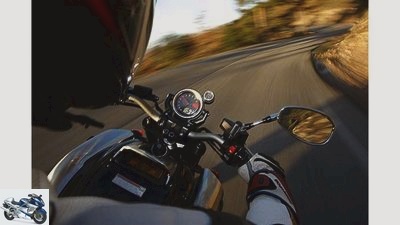
Artist
1/38
…and has to be careful that he does not get sick with constant changes of lean angle.
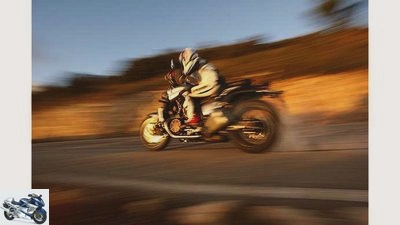
Artist
2/38
The machine can get across. By the way: The Bridgestone BT028 used defied all hardships. Even after the brutal acceleration scenarios for the photo, the test drives and around 1000 hard test kilometers, the rear tire was still in such good shape that the replacement tire did not need to be fitted. The machine was handed over to the sister magazine PS, which carried out its stunt and test drives with the same tire. And he still has a profile…

Artist
3/38
…or the gigantic 320 brake discs in wave design. No matter where the eye goes, you involuntarily get stuck. Artists let off steam here. And apparently made specifications for the technicians. Because even if you go very close…
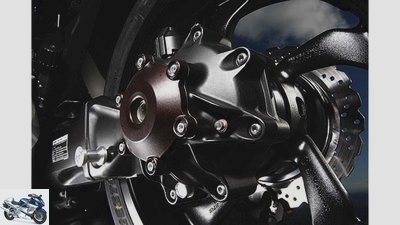
Artist
4/38
…or the cardan drive, which incidentally hardly causes any disruptive reactions when driving. Anyone who has looked at the photos up to this point may wonder how and under what circumstances these very cool-looking photos were taken. So at this point a little digression: Unfortunately, you can’t see the temperature on the recordings…
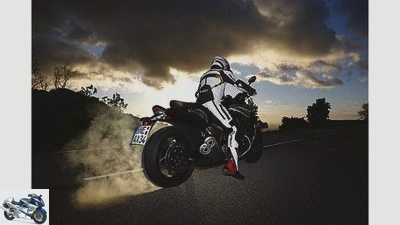
Artist
5/38
The measurement runs, which determined a record acceleration of just 2.7 seconds, only take place on the closed route on the day after this photo production. However, the brute acceleration of the Vmax was staged on site.
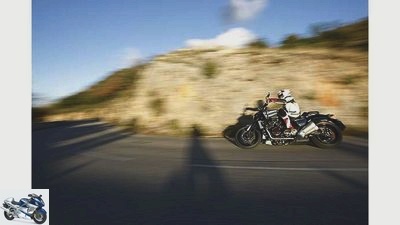
Artist
6/38
Here is a shot in which the photographer’s shadow has to be retouched from the image later. Depending on the game with shutter speed and focus range, the driver has to drive through the same curve up to 25 times until the photo is correct…
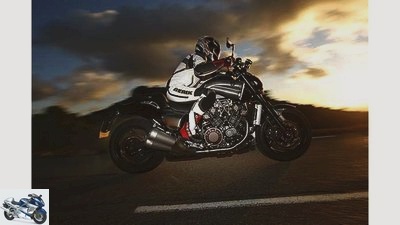
Artist
7/38
That means extreme concentration, because the hot, spinning tire slides over the asphalt as if it were soaped with soap…
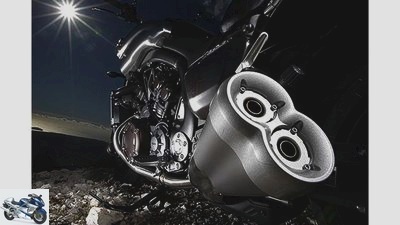
Artist
8/38
The technicians also agreed on the subject of sound: robust, crisp, deep ?? Far more impressive ex works than many a Harley. The machine has two titanium mufflers..
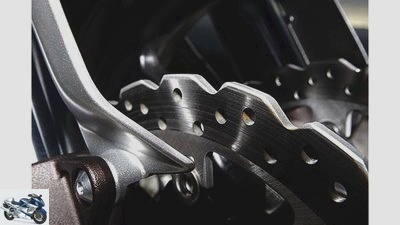
Artist
9/38
…shows the loving fusion of design and technology, which documents what is currently feasible almost everywhere…
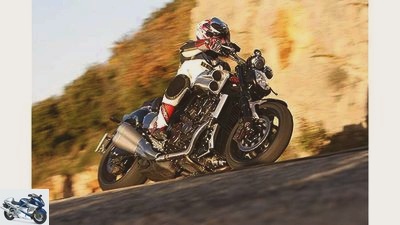
Artist
10/38
…while the photographer is constantly changing perspective,…
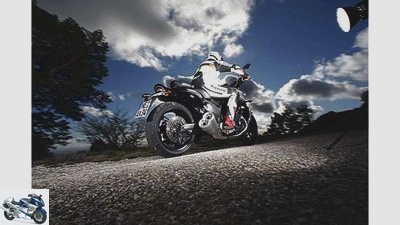
Artist
11/38
Some driving shots, which should also be made using flash technology (see tripod on the right), turned out to be problematic. Due to the relatively short shutter speed when flashing in combination with the low speed, it looks in the photos as if the wheels are stationary and not turning.
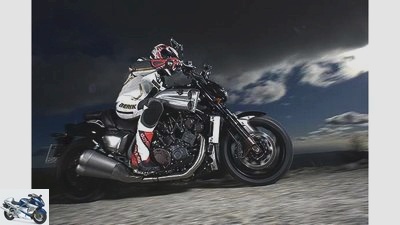
Artist
12/38
The turning of the wheels is then generated on the computer. And then it looks like this….
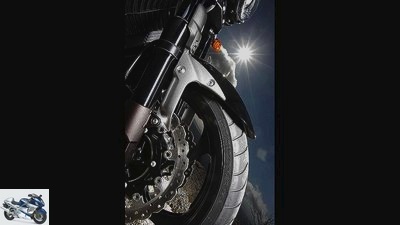
Artist
13/38
…the attachment for the front fender…
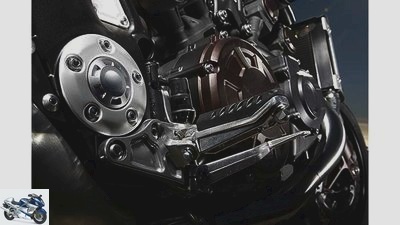
Artist
14/38
Even from the ant’s perspective there are wonderful views. Be it just the footrest, or the cover for the swing arm bearing, the magnesium cover for the clutch…
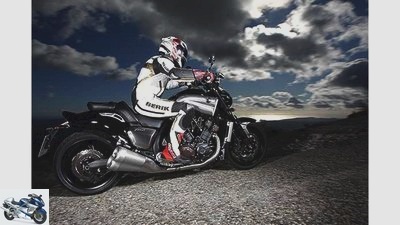
Artist
15/38
…Unfortunately, the whole thing has little to do with dynamics. The decision in favor of some flashed photos was only made because they would go well with the details due to their surreal appearance. The photographer and editor then changed locations for the action photos.

Artist
16/38
In sprint mode, the machine’s mighty 200 tire spins through to third gear…
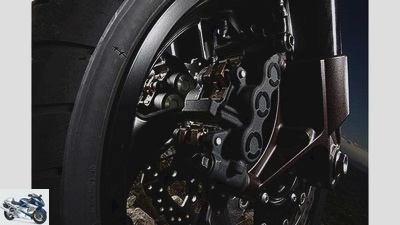
Artist
17/38
…The radially screwed monoblock six-piston fixed calipers are not only the technical and visual icing on the cake, no, they are also ABS-supported. Also the…
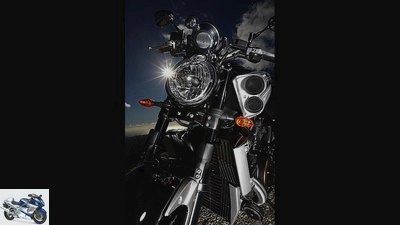
Artist
18/38
…which lead just as huge 52 standpipes. These are coated with titanium oxide, which should make the surface particularly slippery and resistant. Not only does it look good, it also gives the impression that this machine is built to last…
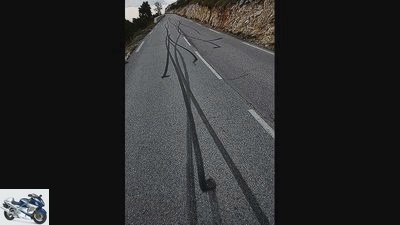
Artist
19/38
I’ll be gone: Test of the Yamaha Vmax 2009 by Rolf Henniges (text) and Jorg Kunstle (photos).

Artist
20/38
A reservoir for the strut installed horizontally is attached behind the right and left passenger footrests. On the right, the compression stage can be adjusted using a handwheel; on the left, the rebound stage is also varied using a handwheel.
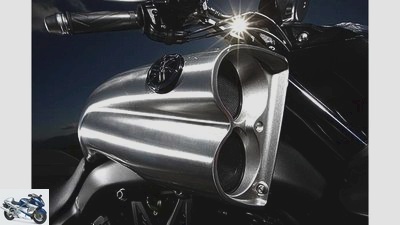
Artist
21/38
In contrast to the old Vmax, in which the intake manifold was only a dummy, the 2009 model breathes greedily through the two extremely eye-catching, hand-polished aluminum snorkels…

Artist
22/38
…Because the sun was shining on December 5th, but the wind on the mountain range was unusually sharp and icy at a felt minus ten degrees. Unfortunately, photographer Jorg Kunstle had forgotten his hat that day and looked like the famous Rumpelstiltskin when it was jumping around the fire with the rolled-up balaclava from editor Rolf Henniges.
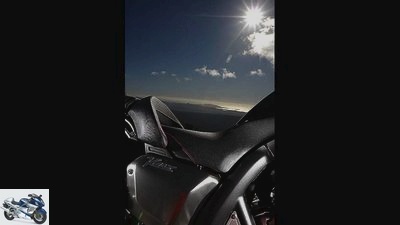
Artist
23/38
…while the bench has been given a small backrest in addition to red decorative stitching…
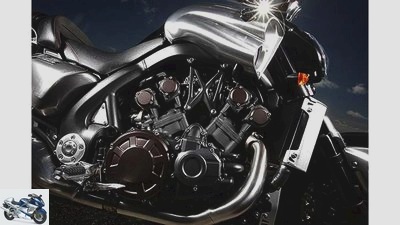
Artist
24/38
The nuclear power plant: A V4 engine that delivers 192 HP at 8900 rpm and 171 Newton meters at 7600 rpm on the MOTORRAD test bench? that’s a bit insane. Mainly because Yamaha dispenses with traction control and the Vmax puts a fat 110 Newton meters on the rear wheel from idle. By the way: minus the power loss, exactly 181 hp arrive at the rear wheel…

Artist
25/38
It’s one of those days when you get torn as a test editor. On the one hand, there is this motorcycle milestone. A bike that suddenly shifts all impressions. Example: If you step out of the saddle of the Vmax into the Harley-Davidson V-Rod Muscle, which is carried for test purposes, and accelerate, you will not get rid of the feeling of riding a 34-horsepower bike. By the way: The Muscle also has over 120 hp and a “Porsche engine”. The downside of such a day is the icy cold despite the warm light, cleaning the morning shift with the machine and the legendary “French breakfast” afterwards. Consists of inedible coffee, a piece of white foam garnished with a sweet spread and watery orange nectar. And at the end of the day a photographer who, thank God, remembers that he has enough flashes with him when the daylight is fading…

Artist
26/38
…which are mounted symmetrically slightly raised on both sides.
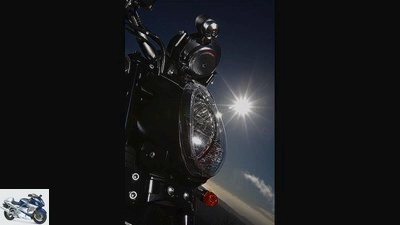
Artist
27/38
…and culminates in such mundane details as the cockpit bracket…
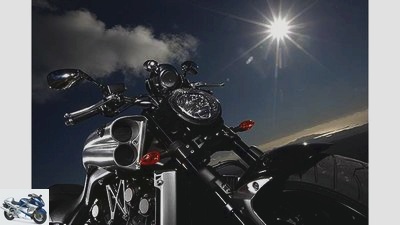
Artist
28/38
…and they were lucky: the sky was bright blue on this Saturday in December, scattered wisps of cloud gave the production a particularly dramatic note….
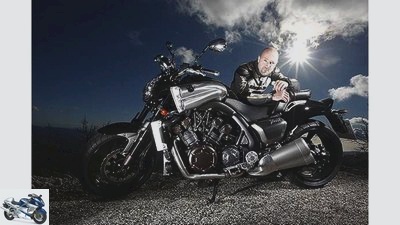
Artist
29/38
Well, the fire in this case was the Vmax. Henniges waited next to the machine for six hours in a perforated leather dress. The fact that he got a little warm was due to the equipment that had to be rebuilt several times for this production: In order to put the details in the futuristic scene, a complete flash system was set up on the untraveled road: three flash heads, several tripods, a dozen heavier Sandbags to weigh down, a cubic meter of tangled cables and an emergency power generator with 2000 watts of power. A huge awning also helped to put the Vmax in the right light.
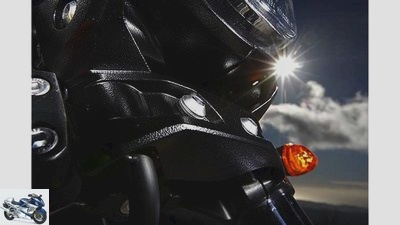
Artist
30/38
…this impression continues on the extremely opulent lamp holder…
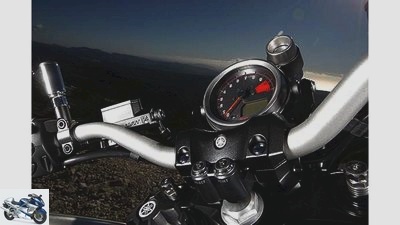
Artist
31/38
…while at the end of the horizon the Mediterranean glittered and put an absolutely surreal stamp on the production. In focus: the handlebars and the cockpit with its huge shift light. When accelerating in sprint mode (the engine management recognizes a sprint from a standstill, more on that later) it flashes every second. This acceleration is just as monumental as the massive handlebar clamp…
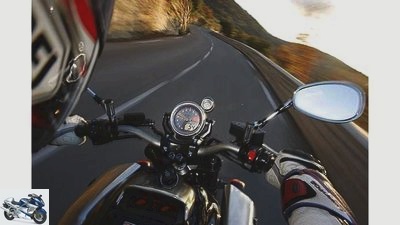
Artist
32/38
… sometimes also sits on the back,…
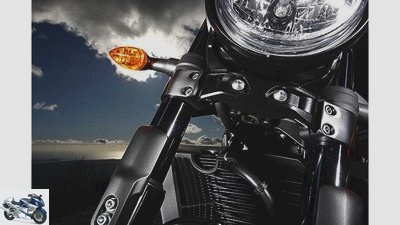
Artist
33/38
…or the massive triple clamps made of die-cast and forged aluminum,…
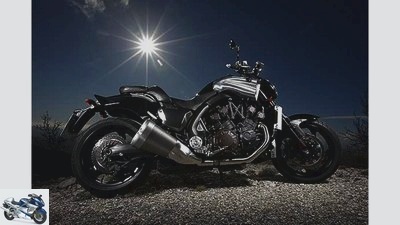
Artist
34/38
So this is how it looks, the 200 hp monster Yamaha Vmax, a milestone in series motorcycle construction. With just 2.7 seconds from zero to 100 km / h, this Yamaha is the bike with the best acceleration ever recorded by MOTORRAD. Without knowing this value beforehand, this visually brute drag bike should be particularly staged for the photo production. Test editor Rolf Henniges and photographer Jorg Kunstle chose a remote pass in southern France as the location for the photo shoot …

Artist
35/38
…then makes the photographer happy, yes…
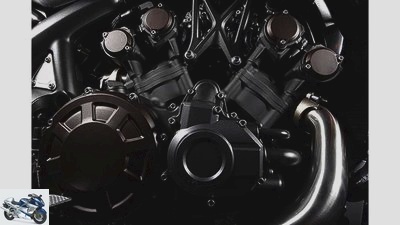
Artist
36/38
…a value that many other bikes can dream of. But let’s go into more detail: The engine management is programmed in such a way that the best possible sprints over the legendary quarter mile are possible? so it says in the Yamaha press release. To put it succinctly: If you accelerate fully from a standstill (regardless of whether from the traffic lights or the starting lights on the drag strip), the engine also turns off in fifth gear. The final speed of the sprint is then just under 260 km / h. The desire to sprint is recognized by comparing the wheel speed (standstill) and the abrupt opening of the throttle valve. As soon as you close the throttle valve a little over the period X (around one or two seconds), the sprint mode is deactivated again and the machine switches to driving mode. Then the top speed is locked in fifth gear at 220 km / h.
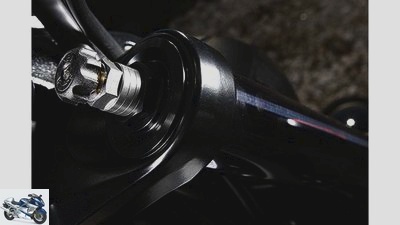
Artist
37/38
…Fork is fully adjustable: While you still need a 17 mm open-ended wrench to change the spring preload, the rebound stage is adjusted using a small handwheel at the top end of the fork.
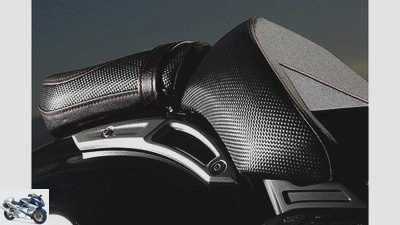
Artist
38/38
…so that the driver can support himself a little when accelerating hard. This backrest must be folded up for refueling. The 15 liter tank is hidden underneath.
motorcycles
Sprint duel
Sprint duel
Yamaha Vmax versus VW Beetle
Markus Jahn
06/18/2009
“I beg your pardon ?? you let yourself be blown away by the bug?” Test driver Karsten had to listen to some biting comments from colleagues at the editorial conference on Monday morning. On the face of it, it smells badly like embarrassment to replace a Beetle with the fastest production machine. As the saying goes: whoever has the damage defies description. In order to avoid any further misunderstandings, however, we should clarify the spicy key data of the matter right away. The two vehicles involved in the little skirmish: a Volkswagen Beetle, built in 1973. Technically not quite standard anymore? Carefully worded ??, outwardly rather unspectacular. Also a Yamaha Vmax, currently the most powerful production motorcycle with 200 hp At the personnel level, the following actors are involved in our speed drama: firstly, Thomas Kemp, 44, owner of the aforementioned Beetle, dragster pilot, civil servant. Second, Karsten Schwers, 37, test and data guru at MOTORRAD. And third, Gert Thole, 53, Head of Test and Technology at MOTORRAD, who organizes it all.
Buy complete article

Sprint duel
Yamaha Vmax versus VW Beetle
6 pages) as PDF
€ 2.00
Buy now
The crucial places of the action: the test chief’s office, where the threads come together, and the former US airbase in Bitburg, where the action starts. The dragster scene meets regularly for sprints on the disused jet fighter runway in the Eifel. The starting point of the unequal duel was a few months ago: While test boss Gert Thole is sitting at his desk, as is so often the case in his office, planning, organizing and editing texts, the phone rings. “Hello Kemp my name. Would you be interested in a dragster race between a VW Beetle and some super-fast acceleration motorcycle, such as the new Vmax? My beetle can do wheelies too!” Spontaneous answer: “Yes Perfect ?? We could use such a Halligalli-full-bottle-smoke-story again. When should we come??”
200 horses against 1 beetle
In his mind’s eye, planner Thole can already see the wheelie beetle being ironed by the series Vmax. After all, there is no doubt about the outcome of the duel. Had the Vmax but recently burned a new acceleration record in the asphalt of southern France from zero to 100 km / h with 2.7 seconds. Which is allegedly also due to an ominous 400-meter dragster mode start-up detection of the engine management. So the matter seemed scratched. Should the Beetle come out of the starting blocks a touch faster in the first few meters, a nominal 200 horsepower under Karsten’s sovereign leadership will make everything flat anyway over 400 meters. No car comes with that. That’s the theory. Why did it work a little differently in practice? Let’s beam ourselves directly into the Saturday launch pad preparations in Bitburg. Contrary to the confidence of his boss, doubts gnaw driver Karsten in the morning. the Yamaha had only arrived in Stuttgart on a transport on Friday evening, no time for tests or preparations. In contrast, the appearance of the four-wheeled opponent looks extremely professional and well-groomed. Thomas Kemp presents an outwardly deliberately inconspicuous, but technically extremely sophisticated one “Brutal Herbie”.
Which isn’t really a surprise. Because hello: If such a guy calls and wants to canned a motorcycle with a VW Beetle, then he’s either from Schwatzbackenhausen? or has a killer trump card up its sleeve. The latter undoubtedly applies to Thomas Kemp. His monster Beetle was once a very good family car. The father bought the Beetle brand new in 1973, drove it for ten years and then in 1983 ?? Son Thomas celebrated his 18th birthday ?? to be handed over to the Filius. He initially drove around on the street as normal until he was attacked by the dragstrip bacillus in 1986. It began an endless life’s work of dragsters.
The current key data of the 1973 Beetle: weight 680 kilograms, engine based on the air-cooled VW Type 4 boxer engine, 2.9 liter displacement, 308 hp. The list of special parts now fills a roll of paper the length from Flensburg to Lake Constance. Doors, hoods, bumpers made of carbon fiber, 62 mm carburetors, titanium valves, manifolds, 103 millimeter pistons, floater clutch with adjustable contact pressure, launch control and and and and. And MOTORCYCLE? Comes to the shootout with a pocket knife in a very casual way. With a standard Yamaha on standard tires, that is strange “only” 182 PS pushes, as it turned out afterwards on the test bench. Although it is exactly the machine that set the record marks in the winter. Also is from the ominous one “Dragstrip mode” nothing felt during the first sprint attempts, and the road tires have as much grip on the drag strip as the neighbor’s dachshund on black ice. Nevertheless, test driver Karsten is highly motivated, has all the expensive data equipment with him and carries a brand new station wagon especially for the television team.
And who is ahead of the game??
But now things are getting serious, the first direct duel is announced. Gentlemen, please start your engines! In the midst of 1000 hp Porsches, Amish sleds and pimped up small cars, Karsten decorates the drag strip with bold black lines while warming up with the only motorcycle. Spectacular ?? but not promising. So he reduces the starting speed to 3000 rpm, lets the clutch slip, left foot with pressure on the gearshift lever, slightly lifted the gas, the next gears served without the clutch and pulled flat. The man on the microphone is enthusiastic and announces with a strong American accent: “Hee, here deerrr Kaaarstunn makes a 10.54 on the 400 million? with a normal street motorcycle!” Karsten, on the other hand, is understatement: “With the Vmax and its long wheelbase, anyone can actually accelerate. But here and now there is no more than 3.0 seconds to a hundred and 10.55 to 400 meters.”
Okay, not bad either, just whether it’s enough? As already suspected, Kafermann Thomas Kemp does his thing with great concentration. His starting ritual is sophisticated down to the smallest detail. First gear, the hydraulic handbrake literally claws the rear wheels on the asphalt and keeps the drive free of play and tension. At the same time, the brake light switch activates Launch Control at a specified starting speed, here in Bitburg 7100 revolutions. Then depress the clutch and accelerator pedal. Traffic light green ?? zack, let the clutch come and release the handbrake. The car lifts the front wheels briefly and shoots forward. Thomas Kemp has to move the long lever for the H shift skillfully and quickly. Transmission, chassis, tire pressure ?? everything perfectly coordinated to optimize traction. The result: 2.44 seconds from zero to one hundred, 10.35 for the 400 meters. Respect, the Beetle is significantly faster to 100 than the Vmax, even after 400 meters it is just ahead! Who would have thought? Test boss Gert has to think again. But one thing is already clear: the whole thing calls for revenge.
Who is faster?
The data analysis clearly shows where the Beetle is doing the meter: namely right at the beginning, right when starting off. It is hard to believe how the Kemp beetle snaps away from a standing start. It only takes 0.8 seconds to accelerate to 50 km / h. The traction is incredible thanks to its fat special tires and the favorable center of gravity. In contrast, the Vmax is still struggling with the spinning rear wheel, so that it only manages to reach 22 km / h in the same period of time. The Vmax fails to catch up with the Beetle’s lead in the further course of the acceleration process, since even the quarter mile is not enough.
It does accelerate faster than the Beetle to 200 km / h and also reaches a higher top speed ?? but the beetle still crosses the finish line just before! A few dozen meters behind the finish line, the Vmax would easily overtake it. Because when the traction problem is no longer an issue, when it comes to performance, weight and air resistance, the Vmax gradually catches up. At 2.16 kg / PS (with driver) it has a similar power-to-weight ratio to the Beetle with 2.19 kg / PS, but at higher speeds the Beetle’s poor aerodynamic drag increasingly acts as a brake. By the way: A Hayabusa or a super athlete would not have been enough to win the VW dragster either, because they also need around 10.5 seconds for the quarter mile.
What’s really up?
Power is of course an indispensable prerequisite for a sprint, you can only really move forward with a lot of pressure. However, if you pull too hard on the cable when you set off, you will face two problems. On the one hand, the rear wheel spins because the tire cannot transmit the power. Normal road tires have a coefficient of friction of barely more than 1. That means: The transferable propulsive force is barely greater than the weight. If, in the optimal case, the entire weight is shifted to the rear wheel when accelerating, this results in a maximum acceleration of one g, that is to say 9.81 m / s2 ?? always provided that the engine delivers this driving force. This corresponds theoretically to 2.83 seconds at 100 km / h.
If you want to be significantly faster, you need tires that stick better, so dragster drivers use very special adhesive tires. The second handicap is wheelie inclination. Even a MotoGP machine accelerates to 100 km / h in 2.4 seconds, not exorbitantly faster than a street athlete, because the front wheel strives towards the sky. For this reason, top-fuel car dragsters have an extremely long wheelbase and a very low center of gravity, so that accelerations of up to 6 g are possible. In plain language: from zero to over 400 km / h in less than 5 seconds!
Related articles
-
counselor Used purchase Used advice Triumph Sprint ST Used advice Triumph Sprint ST Top class Triumphs ST is one of the best among sports tourers. As a…
-
Kawasaki family duel – Z 900 versus Z 1000 R Edition
r-photography.info 18th pictures r-photography.info 1/18 Kawasaki family duel – Z 900 vs. Z 1000 R Edition. r-photography.info 2/18 Kawasaki Z 900: The…
-
New quarter mile sprint record with an e-motorcycle
True cousins 5 pictures True cousins 1/5 The Silver Lightning of the True Cousins racing team delivers 1,632 PS or 1,200 kW. True cousins 2/5 The…
-
Suzuki has canceled all sprint race dates for organizational reasons.
Suzuki Sports & scene Events Suzuki has canceled all sprint race dates for organizational reasons. Suzuki Night Run 2019 All appointments canceled Suzuki…
-
Report – a duel between the generations
Markus Biebricher 7th pictures Breakable 1/7 Sebastian Faab and MOTORRAD editor Thomas Schmieder. Breakable 2/7 Sebastian Faab and MOTORRAD editor Thomas…
-
Honda CB 500 in the 50,000 kilometer test
archive motorcycles Honda CB 500 in the 50,000 kilometer test Honda CB 500 in 50,000 kilometer test (1996) Classic bread-and-butter motorcycle So small,…
-
motorcycles Powerful motorcycles Powerful motorcycles With all my might A motorcycle deserves the title “powerful” not only through its performance. Or…
-
motorcycles Roll-out MV Agusta F4-750 Roll-out MV Agusta F4-750 Ago’s comeback Around a quarter of a century after his last World Championship title on…
-
48 hp motorcycles 300 cc entry level comparison test 2018
Rossen Gargolov 23 pictures Rossen Gargolov 1/23 Right in the middle of the golden October. Rossen Gargolov 2/23 The test field consists of entry-level…
-
www.bilski-fotografie.de 10 pictures bilski-fotografie.de 1/10 Benelli 254 bilski-fotografie.de 2/10 Benelli 254 bilski-fotografie.de 3/10 It’s…